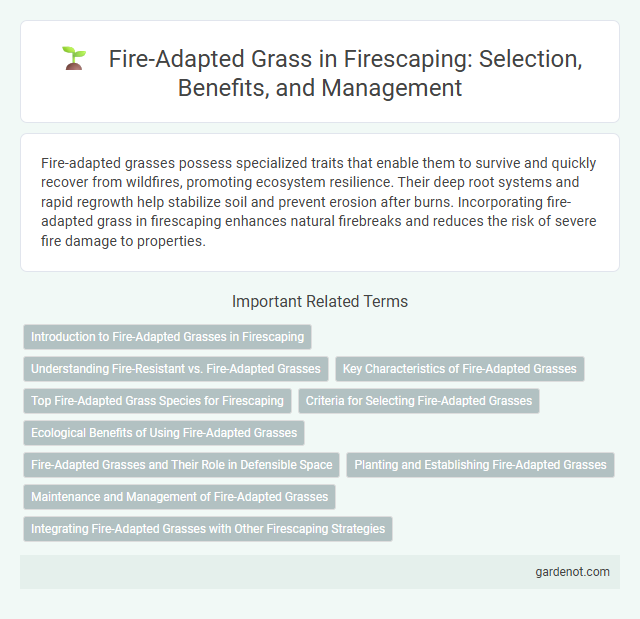Fire-adapted grasses possess specialized traits that enable them to survive and quickly recover from wildfires, promoting ecosystem resilience. Their deep root systems and rapid regrowth help stabilize soil and prevent erosion after burns. Incorporating fire-adapted grass in firescaping enhances natural firebreaks and reduces the risk of severe fire damage to properties.
Introduction to Fire-Adapted Grasses in Firescaping
Fire-adapted grasses such as muhly grass, bluestem, and switchgrass possess natural resilience to periodic fires, promoting rapid regrowth and soil stabilization. These grasses contribute to reducing wildfire severity by maintaining low fuel loads and supporting firebreaks in landscapes. Utilizing fire-adapted grass species in firescaping enhances ecosystem health and fire management by encouraging ecological balance and fire resilience.
Understanding Fire-Resistant vs. Fire-Adapted Grasses
Fire-adapted grasses possess traits such as deep root systems and rapid post-fire regrowth, enabling them to survive and even thrive after wildfires. Fire-resistant grasses, in contrast, minimize fire spread by maintaining higher moisture content and lower flammability but may not recover quickly once burned. Recognizing the distinctions between fire-adapted and fire-resistant grasses is crucial for effective firescaping strategies that aim to reduce wildfire risk while preserving ecosystem resilience.
Key Characteristics of Fire-Adapted Grasses
Fire-adapted grasses possess key characteristics such as rapid post-fire regeneration, deep root systems that protect vital growth tissues, and high flammability that helps carry low-intensity fires. These grasses often feature narrow leaves with silica content, enhancing their fire resilience and promoting nutrient cycling in fire-prone ecosystems. Their ability to quickly resprout after burns supports ecosystem recovery and reduces wildfire severity.
Top Fire-Adapted Grass Species for Firescaping
Top fire-adapted grass species for firescaping include Schizachyrium scoparium (Little Bluestem), Andropogon gerardii (Big Bluestem), and Sporobolus heterolepis (Prairie Dropseed). These grasses possess high heat tolerance and rapid post-fire regeneration, making them ideal for landscape designs aimed at reducing wildfire risk. Incorporating native fire-adapted grasses enhances ecosystem resilience while providing aesthetic and ecological benefits in fire-prone areas.
Criteria for Selecting Fire-Adapted Grasses
Fire-adapted grasses should possess traits such as rapid regrowth after burning, high moisture content during fire seasons, and natural resistance to fire damage to ensure landscape resilience. Selecting species native to the local ecosystem enhances compatibility with existing flora and minimizes invasive risks. Prioritizing grasses with deep root systems and low fuel load contributes to effective fire management and soil stabilization in firescaping efforts.
Ecological Benefits of Using Fire-Adapted Grasses
Fire-adapted grasses enhance soil stability by reducing erosion and promoting nutrient cycling, which supports healthier ecosystems. Their ability to regenerate quickly after fire disturbances helps maintain biodiversity and provides critical habitat for wildlife. Integrating these grasses into firescaping strategies minimizes wildfire spread while fostering resilient natural landscapes.
Fire-Adapted Grasses and Their Role in Defensible Space
Fire-adapted grasses, such as Buford bluegrass and little bluestem, play a crucial role in creating defensible space by reducing fuel loads and slowing wildfire spread around properties. These grasses possess natural resistance to fire, quickly regenerating after burns and promoting soil stability while minimizing erosion risks. Integrating fire-adapted grasses into landscape design enhances fire safety by maintaining a resilient, low-flammability ground cover essential for effective fire management.
Planting and Establishing Fire-Adapted Grasses
Planting fire-adapted grasses requires selecting native species such as Blue Grama (Bouteloua gracilis) or Big Bluestem (Andropogon gerardii) known for their resilience to periodic fires. Establishing these grasses involves preparing well-drained soil, sowing seeds during early spring or fall, and ensuring consistent moisture until seedlings are robust. Fire-adapted grasses promote ecosystem health by reducing fuel loads and recovering quickly post-fire, making them essential for sustainable firescaping practices.
Maintenance and Management of Fire-Adapted Grasses
Fire-adapted grasses require regular maintenance through controlled burns or mowing to prevent excessive thatch buildup and promote healthy regrowth. Proper management includes monitoring soil moisture and nutrient levels to support resilience against invasive species and drought stress. Implementing rotational burning schedules enhances ecosystem stability while maintaining the natural fire regime critical for these grasses' survival and biodiversity.
Integrating Fire-Adapted Grasses with Other Firescaping Strategies
Fire-adapted grasses such as Little Bluestem and Buffalo Grass enhance firescaping by promoting natural fire cycles that reduce fuel buildup. Integrating these grasses with fire-resistant shrubs and strategically placed hardscapes creates effective fuel breaks while maintaining ecological balance. Combining multiple fire-adapted plant species optimizes landscape resilience and supports biodiversity in high-risk fire zones.
Fire-adapted grass Infographic

 gardenot.com
gardenot.com